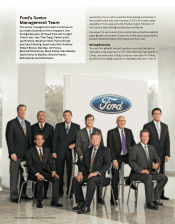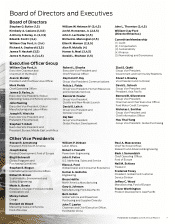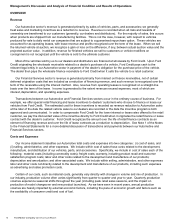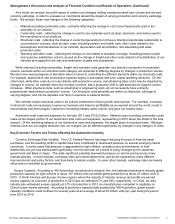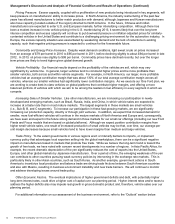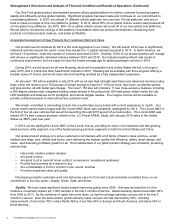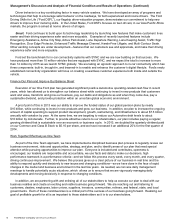Ford 2013 Annual Report Download - page 14
Download and view the complete annual report
Please find page 14 of the 2013 Ford annual report below. You can navigate through the pages in the report by either clicking on the pages listed below, or by using the keyword search tool below to find specific information within the annual report.12 Ford Motor Company | 2013 Annual Report
Management’s Discussion and Analysis of Financial Condition and Results of Operations (Continued)
Pricing Pressure. Excess capacity, coupled with a proliferation of new products being introduced in key segments, will
keep pressure on manufacturers’ ability to increase prices. In North America, the industry restructuring of the past few
years has allowed manufacturers to better match production with demand, although Japanese and Korean manufacturers
also have capacity (located outside of the region) directed to North America. In the future, Chinese and Indian
manufacturers are expected to enter U.S. and European markets, further intensifying competition. Although there has
been a modest increase in new vehicle pricing in the U.S. market during 2013, it seems likely that over the long term
intense competition and excess capacity will continue to put downward pressure on inflation-adjusted prices for similarly-
contented vehicles in the United States and contribute to a challenging pricing environment for the automotive industry. In
Europe, the excess capacity situation was exacerbated by weakening demand and the lack of reductions in existing
capacity, such that negative pricing pressure is expected to continue for the foreseeable future.
Commodity and Energy Price Increases. Despite weak demand conditions, light sweet crude oil prices increased
from an average of $79 per barrel in 2010 to $95 per barrel in 2011, before declining slightly to about $94 per barrel in late
2012. In 2013, oil prices rose slightly to $98 per barrel. Commodity prices have declined recently, but over the longer
term prices are likely to trend higher given global demand growth.
Vehicle Profitability. Our financial results depend on the profitability of the vehicles we sell, which may vary
significantly by vehicle line. In general, larger vehicles tend to command higher prices and be more profitable than
smaller vehicles, both across and within vehicle segments. For example, in North America, our larger, more profitable
vehicles had an average contribution margin that was about 130% of our total average contribution margin across all
vehicles, whereas our smaller vehicles had significantly lower contribution margins. As we execute our One Ford plan, we
are working to create best-in-class vehicles on global platforms that contribute higher margins, and offering a more
balanced portfolio of vehicles with which we aim to be among the leaders in fuel efficiency in every segment in which we
compete.
Increasing Sales of Smaller Vehicles. Like other manufacturers, we are increasing our participation in newly-
developed and emerging markets, such as Brazil, Russia, India, and China, in which vehicle sales are expected to
increase at a faster rate than in most mature markets. The largest segments in these markets are small vehicles
(i.e., Sub-B, B, and C segments). To increase our participation in these fast-growing markets, we are significantly
increasing our production capacity, directly or through joint ventures. In addition, we expect that increased demand for
smaller, more fuel-efficient vehicles will continue in the mature markets of North America and Europe and, consequently,
we have seen and expect in the future strong demand in those markets for our small car offerings (including our new Ford
Fiesta and Focus models that are based on global platforms). Although we expect positive contribution margins from
higher small vehicle sales, one result of increased production of small vehicles may be that, over time, our average per
unit margin decreases because small vehicles tend to have lower margins than medium and large vehicles.
Trade Policy. To the extent governments in various regions erect or intensify barriers to imports, or implement
currency policy that advantages local exporters selling into the global marketplace, there can be a significant negative
impact on manufacturers based in markets that promote free trade. While we believe the long-term trend is toward the
growth of free trade, we have noted with concern recent developments in a number of regions. In Asia Pacific Africa, for
example, the recent dramatic depreciation of the yen significantly reduces the cost of exports into the United States,
Europe, and other global markets by Japanese manufacturers. Over a period of time, the emerging weakness of the yen
can contribute to other countries pursuing weak currency policies by intervening in the exchange rate markets. This is
particularly likely in other Asian countries, such as South Korea. As another example, government actions in South
America to incentivize local production and balance trade are driving trade frictions between South American countries
and also with Mexico, resulting in business environment instability and new trade barriers. We will continue to monitor
and address developing issues around trade policy.
Other Economic Factors. The eventual implications of higher government deficits and debt, with potentially higher
long-term interest rates, could drive a higher cost of capital over our planning period. Higher interest rates and/or taxes to
address the higher deficits also may impede real growth in gross domestic product and, therefore, vehicle sales over our
planning period.
For additional information on our assessment of the business environment, refer to the “Outlook” section below.




